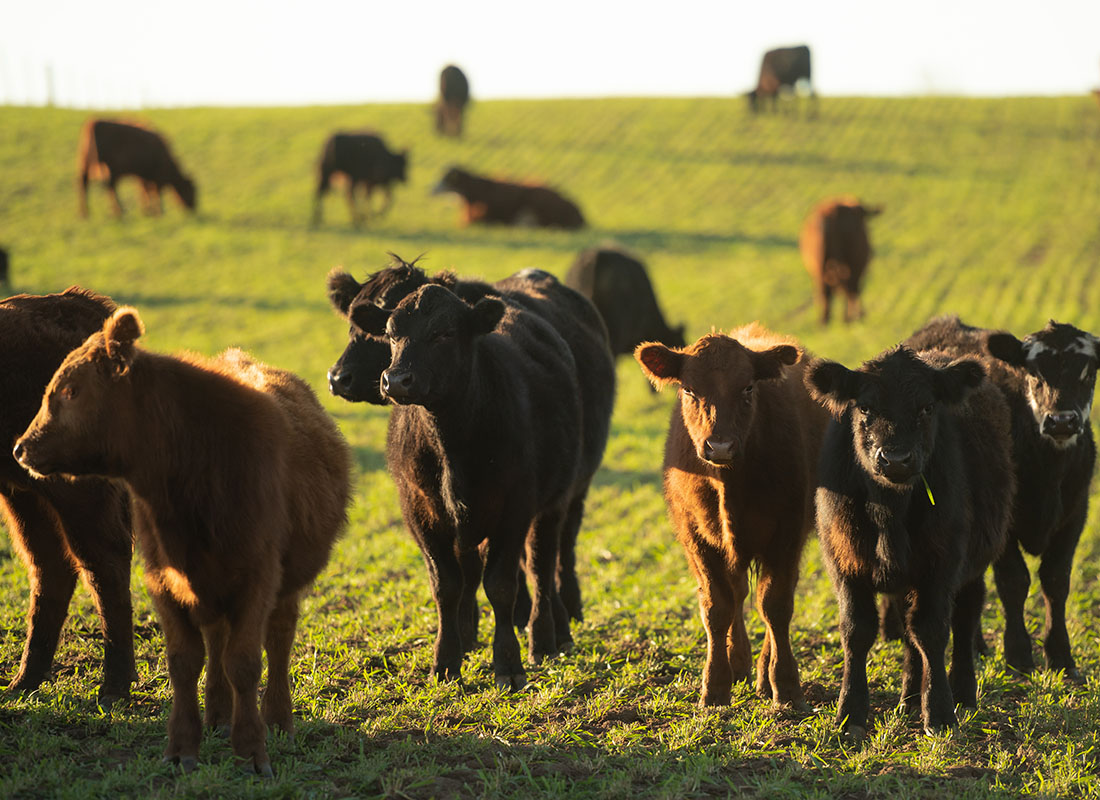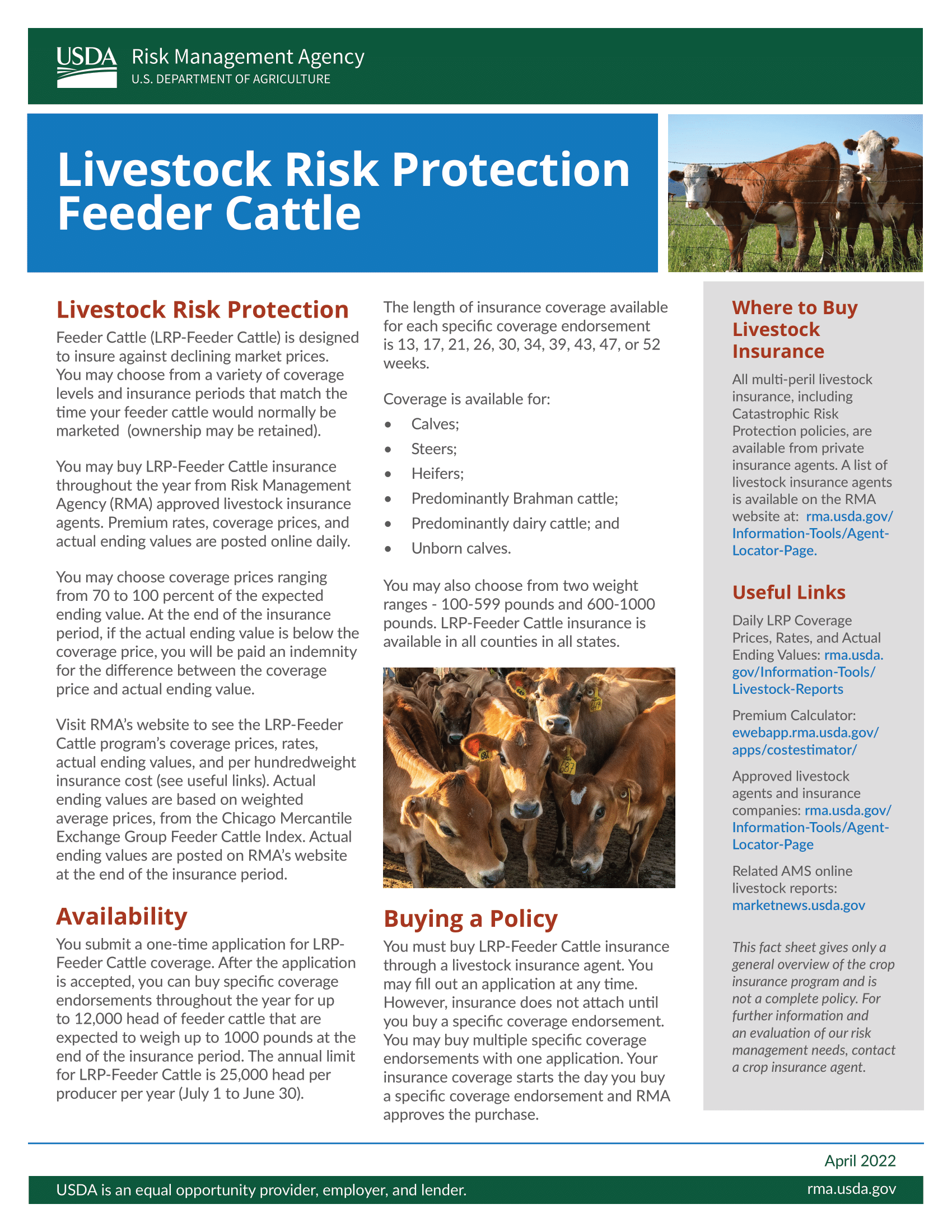Bagley Risk Management : Protecting Your Company Future
Wiki Article
The Benefits of Animals Danger Security (LRP) Insurance Coverage Clarified
Livestock Risk Defense (LRP) insurance coverage acts as an important device for animals manufacturers navigating the uncertain surface of market changes and unexpected losses. Past providing economic safety, this form of insurance coverage provides a critical technique to risk management in the farming industry. With customized plans developed to satisfy the certain needs of private producers and the option to gain from government aids, LRP insurance offers a detailed remedy to securing livelihoods when faced with difficulty. The true worth and complexities of this insurance policy tool go much beyond plain protection-- they embody a proactive technique that can redefine the landscape for animals manufacturers.Financial Protection Against Market Volatility

LRP insurance supplies manufacturers with a valuable device to take care of rate risk, offering protection that can aid counter potential losses arising from unfavorable market motions. This insurance coverage permits producers to secure a guaranteed price for their animals, supplying a degree of assurance in an or else volatile market. By securing versus unforeseen cost decreases, producers can much better plan and budget for their operations, eventually improving their monetary security and strength in the face of market uncertainties. Basically, LRP insurance serves as a proactive danger administration strategy that equips animals producers to navigate the difficulties of a dynamic market landscape with better self-confidence and security.
Insurance Coverage for Unforeseen Losses
Animals Danger Defense (LRP) insurance coverage offers detailed coverage to secure animals producers versus unforeseen losses in the unpredictable market landscape. This insurance supplies protection in cases where unanticipated events such as condition episodes, natural calamities, or significant market value variations can cause economic hardships for livestock manufacturers. By having LRP coverage, producers can alleviate the threats related to these unanticipated circumstances and make certain a level of economic stability for their operations.
Among the essential benefits of LRP insurance is that it enables producers to tailor their protection based upon their specific needs and risk tolerance. This versatility enables producers to customize their policies to safeguard versus the kinds of losses that are most relevant to their operations. Additionally, LRP insurance provides an uncomplicated cases procedure, aiding manufacturers quickly recover from unforeseen losses and resume their operations without substantial disruptions.
Danger Management for Livestock Producers

One trick aspect of danger administration for livestock manufacturers is diversity. By diversifying their animals portfolio, producers can spread out risk across various species or breeds, reducing the effect of a potential loss in any kind of solitary location. In addition, keeping in-depth and exact documents can help producers determine patterns, fads, and potential locations of threat within their procedures.
Insurance items like Livestock Risk Defense (LRP) can also play a crucial role in threat administration. LRP insurance coverage supplies manufacturers with a security net against unanticipated rate declines, offering them comfort and economic safety and security in times of market instability. Generally, a thorough threat monitoring strategy that incorporates record-keeping, insurance, and diversity can help animals manufacturers properly navigate the challenges of the sector.
Tailored Policies to Suit Your Requirements
Tailoring insurance policy policies to straighten with the details requirements and situations of livestock manufacturers is vital in making certain thorough threat monitoring techniques (Bagley Risk Management). Animals producers face a myriad of obstacles special to their industry, such as fluctuating market value, unforeseeable original site weather patterns, and animal health issues. To resolve these dangers successfully, insurance providers supply tailored plans that satisfy the diverse needs of animals manufacturersOne secret aspect of tailored animals insurance policies is the capability to customize protection limits based upon the size of the operation and the kinds of livestock being raised. This flexibility ensures that producers are not over-insured or under-insured, allowing them to shield their assets adequately without spending Look At This for unneeded insurance coverage.
Furthermore, customized plans might also include specific provisions for various sorts of livestock operations, such as dairy products farms, livestock ranches, or poultry producers. By tailoring protection to fit the distinct features of each operation, insurance policy carriers can supply extensive security that deals with the particular dangers faced by various kinds of animals manufacturers. Inevitably, choosing a tailored insurance plan can give satisfaction and financial safety for livestock producers despite unanticipated challenges.
Government-Subsidized Insurance Options
In thinking about danger administration techniques tailored to the particular requirements of animals manufacturers, it is vital to check out the Government-subsidized insurance policy options readily available to mitigate monetary unpredictabilities effectively. Government-subsidized insurance choices play an essential function in offering budget friendly danger monitoring tools for livestock manufacturers (Bagley Risk Management). These programs are created to sustain manufacturers in protecting their procedures versus different threats such as rate variations, all-natural catastrophes, and other unpredicted occasions that could impact their lower line. By offering subsidies, the government intends to make insurance much more available and economical for producers, motivating them to proactively handle their threats.One prominent example of a government-subsidized insurance policy alternative is the Livestock Threat Defense (LRP) program, which provides security against a decline in market costs. With LRP, producers can guarantee their livestock at a certain coverage level, thus guaranteeing a minimal price for their pets at the end of the insurance policy duration. By leveraging these subsidized insurance choices, animals manufacturers can enhance their financial safety and security and security, inevitably adding to the durability of the agricultural sector all at once.
Conclusion

In conclusion, Livestock Risk Security (LRP) insurance provides financial security against market volatility and unexpected losses for livestock manufacturers. It functions as a beneficial risk administration tool, this post with tailored policies to match private requirements. Government-subsidized insurance coverage alternatives further boost the availability and affordability of LRP insurance policy for producers. Consider LRP insurance coverage as a calculated financial investment to guard your animals procedure against possible dangers and unpredictabilities in the market.
Animals Danger Protection (LRP) insurance policy serves as an essential tool for animals producers browsing the unpredictable surface of market fluctuations and unanticipated losses.In today's unpredictable market atmosphere, animals manufacturers can profit dramatically from protecting financial security against market volatility with Animals Threat Defense (LRP) insurance policy. In essence, LRP insurance coverage offers as a proactive threat administration technique that encourages animals manufacturers to navigate the challenges of a dynamic market landscape with greater self-confidence and safety and security.
Livestock Risk Defense (LRP) insurance uses detailed insurance coverage to guard animals producers against unexpected losses in the volatile market landscape.In verdict, Livestock Threat Security (LRP) insurance coverage provides economic protection versus market volatility and unanticipated losses for livestock manufacturers.
Report this wiki page